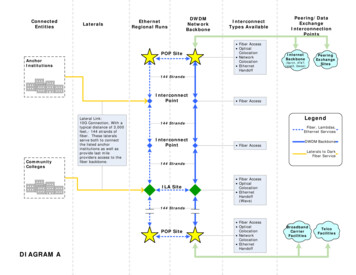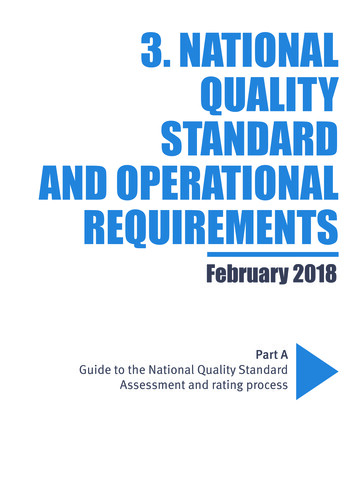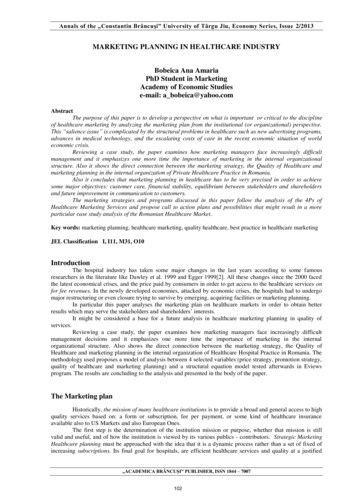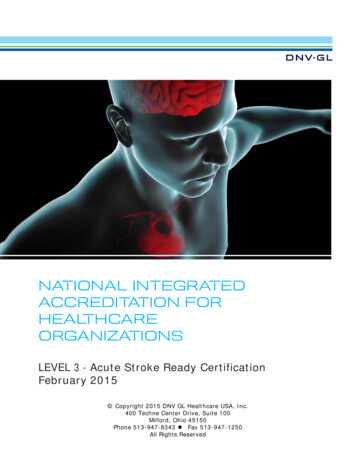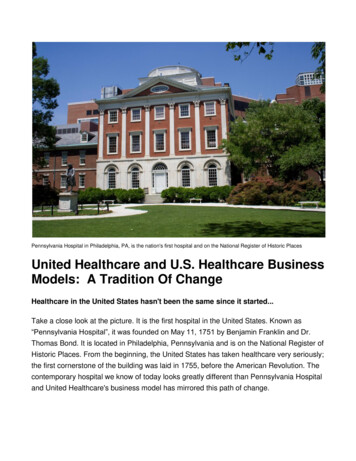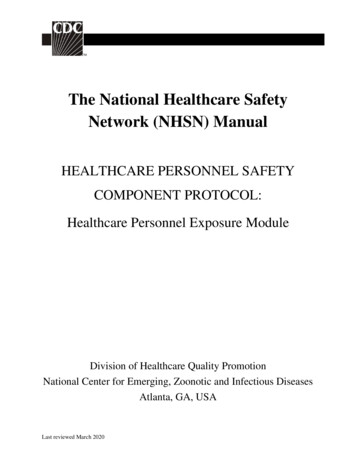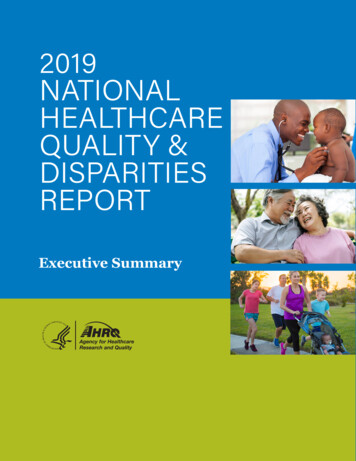
Transcription
2019NATIONALHEALTHCAREQUALITY &DISPARITIESREPORTExecutive Summary
This document is in the public domain and may be used and reprinted withoutpermission. Citation of the source is appreciated. Suggested citation: 2019 NationalHealthcare Quality and Disparities Report. Rockville, MD: Agency for HealthcareResearch and Quality; December 2020. AHRQ Pub. No. 20(21)-0045-EF.
2019 NATIONAL HEALTHCAREQUALITY AND DISPARITIES REPORTU.S. DEPARTMENT OFHEALTH AND HUMAN SERVICESAgency for Healthcare Research and Quality5600 Fishers LaneRockville, MD 20857www.ahrq.govAHRQ Publication 20(21)-0045-EFDecember ml
ACKNOWLEDGMENTSThe National Healthcare Quality and Disparities Report (NHQDR) is the product of collaboration amongagencies from the U.S. Department of Health and Human Services (HHS), other federal departments, andthe private sector. Many individuals guided and contributed to this effort. Without their magnanimoussupport, the report would not have been possible. Specifically, we thank:Primary AHRQ Staff: Gopal Khanna, David Meyers, Virginia Mackay-Smith, Jeff Brady, Erin Grace,Karen Chaves, Darryl Gray, Barbara Barton, Doreen Bonnett, Irim Azam, and Cecilia Hahn.HHS Interagency Workgroup (IWG) for the NHQDR: Girma Alemu (HRSA), Irim Azam (AHRQ),Andreea Balan-Cohen (IMPAQ), Barbara Barton (AHRQ), Doreen Bonnett (AHRQ), Deron Burton (CDC),Victoria Chau (SAMHSA), Karen Chaves (AHRQ), Xiuhua Chen (Atlas Research), Deborah Duran (NIHNIMHD), Melissa Evans (CMS), Camille Fabiyi (AHRQ), Paul Gorrell (Atlas Research), Darryl Gray(AHRQ), Kirk Greenway (IHS), Sarah Heppner (HRSA), Ed Huff (CMS), DeLoris Hunter (NIH-NIMHD),Susan Jenkins (ACL), Christine Lee (FDA), Doris Lefkowitz (AHRQ), Jesse Lichstein (HRSA), Lan Liang(AHRQ), Shari Ling (CMS), Iris Mabry-Hernandez (AHRQ), Marlene Matosky (HRSA), Tracy Matthews(HRSA), Christine Merenda (FDA), Kamila Mistry (AHRQ), Ernest Moy (VHA), Samia Noursi (NIHNIDA), Kathy O’Connor (CDC), Rajasri Roy (NIH-OD-ORWH), Dianne Rucinski (OASH), Asel Ryskulova(CDC), Adelle Simmons (ASPE), Robin Streeter (HRSA), Loida Tamayo (CMS), Caroline Taplin (ASPE),Emmanuel Taylor (NIH-NCI), Michelle Washko (HRSA), and Ying Zhang (IHS).IWG Subgroup – Access to Care: Karen Chaves (Chair), Girma Alemu (HRSA), Robin Cohen (CDC),Kirk Greenway (IHS), Lan Liang (AHRQ), Pradip Muhuri (AHRQ), Barbara Barton (AHRQ).NHQDR Team: Irim Azam (CQuIPS), Barbara Barton (CQuIPS), Doreen Bonnett (OC), Xiuhua Chen(Atlas Research), James Cleeman (CQuIPS), Noel Eldridge (CQuIPS), Camille Fabiyi (OEREP), PaulGorrell (Atlas Research), Erin Grace (CQuIPS), Darryl Gray (CQuIPS), Lan Liang (CFACT), Kamila Mistry(OEREP), Margie Shofer (CQuIPS).HHS Data Experts: Cuong Bui (HRSA), Lara Bull (CDC), Robin Cohen (CDC-NCHS), Joann Fitzell(CMS), Elizabeth Goldstein (CMS), Irene Hall (CDC-HIV), Norma Harris (CDC-HIV), Pradip Muhuri(AHRQ), Jessica King (NPCR), Amanda Lankford (CDC), Denys Lau (CDC-NCHS), Lan Liang (AHRQ),Sharon Liu (SAMHSA), Marlene Matosky (HRSA), Tracy Matthews (HRSA), Robert Morgan (CMS),Richard Moser (NIH-NCI), Kathy O’Connor (CDC-NCHS), Robert Pratt (CDC), Neil Russell (SAMHSA),Asel Ryskulova (CDC-NCHS), Alek Sripipatana (HRSA), Reda Wilson (CDC- NCCDPHP-ONDIEH), EmilyZammitti (CDC-NCHS), and Xiaohong (Julia) Zhu (HRSA).Other Data Experts: Mark Cohen (ACS NSQIP), Ashley Eckard (University of Michigan), SheilaEckenrode (MPSMS-Qualidigm), Clifford Ko (ACS NSQIP), Vivian Kurtz (University of Michigan),Leticia Nogueira (American Cancer Society), Robin Padilla (University of Michigan KECC), Yun Wang(MPSMS-Qualidigm), and Robin Yabroff (American Cancer Society).Other AHRQ Contributors: Cindy Brach, Edwin Lomotan, Karen Migdail, Pamela Owens, WendyPerry, Mary Rolston, Bruce Seeman, Randie Siegel, and Michele Valentine.Data Support Contractors: Atlas Research, IMPAQ International.
EXECUTIVE SUMMARYKey Findings Access: From 2000 through 2016-2018, more than half (11 of 20) of accessmeasures showed improvement, 25% (5 of 20) did not show improvement, and 20%(4 of 20) showed worsening. For example, there were significant gains in thepercentage of people who reported having health insurance.Quality: Quality of healthcare improved overall from 2000 through 2018, but thepace of improvement varied by priority area: Person-Centered Care: Almost half (14 of 29) of person-centered caremeasures were improving overall.Patient Safety: Nearly half (12 of 26) of patient safety measures were improvingoverall.Healthy Living: Almost 60% (41 of 70) of healthy living measures were improvingoverall.Effective Treatment: More than 40% (15 of 36) of effective treatmentmeasures were improving overall.Care Coordination: Nearly 40% (3 of 8) of care coordination measures wereimproving overall.Care Affordability: Forty percent (2 of 5) of affordable care measures wereimproving overall.Disparities: Overall, some disparities were getting smaller from 2000 through2016-2018, but disparities persist and some even worsened, especially for poor i anduninsured populations in all priority areas. Racial and ethnic disparities vary by group: For about 40% of quality measures, Blacks (82 of 202) and American Indiansand Alaska Natives (47 of 116) received worse care than Whites. For morethan one-third of quality measures, Hispanics (61 of 177) received worse carethan Whites. For nearly 30% of quality measures, Asians (52 of 185) received worse carethan Whites, but Asians received better care than Whites for nearly one-third(56 of 185) of quality measures.iPoor is defined as having family income below 100% of the federal poverty level (FPL).2019 National Healthcare Quality and Disparities Report ES1
Executive Summary For one-third of quality measures, Native Hawaiians/Pacific Islanders (24 of72) received worse care than Whites. Disparities vary by residence location: For nearly a quarter (24 of 102) of quality measures, residents of large centralmetropolitan areas received worse care than residents of large fringemetropolitan areas. For one-third of quality measures, residents of micropolitan and noncoreareas received worse care than residents of large fringe metropolitan areas. For a little less than 20% of quality measures, medium and smallmetropolitan residents received worse care than residents of large fringemetropolitan areas.About the National Healthcare Quality and Disparities ReportFor the 17th year in a row, AHRQ is reporting on healthcare quality and disparities. Theannual National Healthcare Quality and Disparities Report (NHQDR) is mandated byCongress to provide a comprehensive overview of the quality of healthcare received bythe general U.S. population and disparities in care experienced by different racial andsocioeconomic groups.The report assesses the performance of our healthcare system and identifies areas ofstrength and weakness, as well as disparities, for access to healthcare and quality ofhealthcare. Quality measures are grouped by priority areas, including person-centeredcare, patient safety, healthy living, effective treatment, care coordination, andaffordable care.More than 250 measures used in these reports span a wide range of structure, process,and outcome measures for which existing national data sources can be used. This reportpresents selected findings in each priority area and examples of large disparities,disparities worsening over time, and disparities showing improvement. A U.S.Department of Health and Human Services (HHS) Interagency Work Group (IWG) ii thatFederal participants on IWG: AHRQ, Administration for Children and Families, Administration forCommunity Living, Assistant Secretary for Planning and Evaluation, Centers for Disease Control andPrevention, Centers for Medicare & Medicaid Services, Food and Drug Administration, Health Resourcesand Services Administration, Indian Health Service, National Institutes of Health, Office of the AssistantSecretary for Health, Substance Abuse and Mental Health Services Administration, and Veterans HealthAdministration.iiES2 2019 National Healthcare Quality and Disparities Report
Executive Summarysupports the reports selected the measures for tracking based on their importance,scientific soundness, and feasibility.Social Determinants of HealthHealthcare quality and delivery affect each person’s healthcare outcomes, but manyother factors contribute to individual health. An integral part of delivering high-qualityhealthcare is understanding the social determinants of health (SDOH) of patients and ofcommunities in which healthcare is provided. The World Health Organization definesSDOH as the conditions in which people are born, grow, live, work, and age.SDOH can be discussed in the following contexts: Social context (e.g., demographics, social networks and supports; social cohesion;discrimination based on race, ethnicity, religion, sex, and gender identity;community safety; criminal justice climate; civic participation).Economic context (e.g., employment, income, poverty).Education (e.g., quality of daycare, schools, and adult education; literacy andhigh school graduation rates; English proficiency).Physical infrastructure (e.g., housing, transportation, workplace safety, foodavailability, parks and other recreational facilities, environmental conditions,sufficiency of social services).Healthcare context (e.g., access to high-quality, culturally and linguisticallyappropriate, and health-literate care; access to insurance; healthcare laws; healthpromotion initiatives; supply side of services; attitudes toward healthcare; anduse of services). 1This report examines SDOH by highlighting disparities experienced by varioussubpopulations. Policymakers, researchers, providers, and other stakeholders can usethis report’s analyses to understand the outcomes for racial and ethnic, insurance,income, and residence location groups.Reference1.Agency for Healthcare Research and Quality. About SDOH in Healthcare. Content lLast reviewedFebruary 2020. Agency for Healthcare Research and Quality, Rockville, MD.https://www.ahrq.gov/sdoh/about.html. Accessed September 14, 2020.2019 National Healthcare Quality and Disparities Report ES3
2019 National Healthcare Quality 3and Disparities Report ES. supports the reports selected the measures for tracking based on their importance, scientific soundness, and feasibility. Social Determinants of Health . Healthcare quality and delivery affect each person's healthcare outcomes, but many other factors contribute to individual health.
